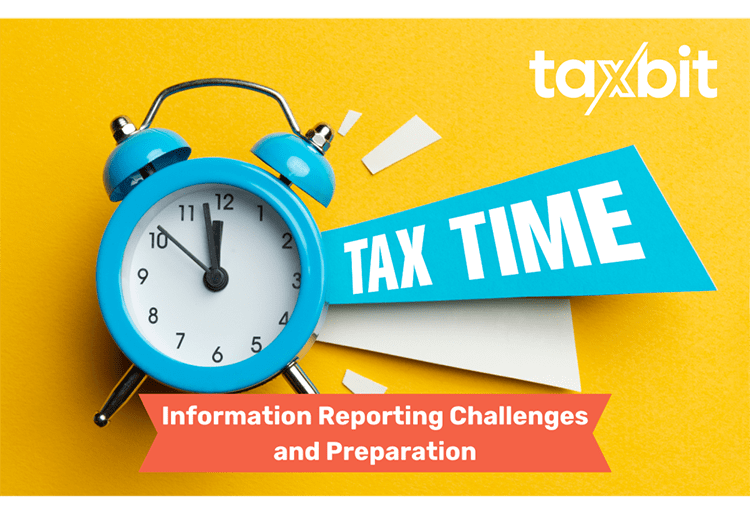Tax Season is unavoidable, but it doesn’t need to be difficult.
Top 5 Challenges with Information Reporting & How to Get Ahead of Tax Season
Tax Season is unavoidable, but it doesn’t need to be difficult.
Businesses often struggle to identify and satisfy their annual tax reporting obligations – and after a difficult, grueling tax season, tend to table discussions about how to enhance their processes, until the cycle repeats itself. At Taxbit, we want to help you break that cycle.
Based on our industry experience, below are the top 5 challenges that our clients face with respect to information reporting, along with some guidance on how to get ahead of these tasks, to ensure tax season goes as smoothly as possible –
- Understanding Requirements and Regulatory Changes
- Data Collection, Validation, & Maintenance
- Extraction, Manipulation, & Transmission of Data
- Eligibility of Customers in Scope for Reporting
- Mechanics of Information Reporting
1. Understanding Requirements and Regulatory Changes
One of the largest challenges with respect to tax information reporting is understanding the evolving regulations that surround information reporting, both domestically in the US and internationally.
Some of these changes occur on an annual basis. For example, Forms 1099 are modified and published each year by the IRS, and it is the responsibility of the tax preparer to identify and understand any changes made to any relevant form types, including any systems utilizing these forms. Others, however, are more nuanced, and unexpected – consider updates to reporting thresholds, or pending regulations. These changes are especially challenging, as they can significantly impact internal processes, as well as expected reporting volumes.
Further — for businesses that operate in multiple jurisdictions, or those considering expansion into a new market, it’s crucial to determine whether any new activity introduces any additional reporting or onboarding requirements. Consider the implementation of DAC7, the European Union’s directive aimed at enhancing tax transparency and cooperation in the digital realm, or the Crypto-Asset Reporting Framework (CARF), which intends to facilitate the automatic exchange of tax relevant-information on crypto-assets.
Those that operate in the EU should read Taxbit’s recent blog posts on compliance with DAC7, and considerations for implementing a DAC7 process.
2. Data Collection, Validation, & Maintenance
A crucial step toward compliance is gathering, organizing, and maintaining all of the various data elements needed to complete any required, downstream reporting. A majority of these data points must be validated for accuracy and completeness, so it’s imperative to compile this information as soon as possible, so that the appropriate troubleshooting and remediation can be performed, well in advance of tax season.
| Category | Required Data Elements |
| Payer | Legal Entity NameRegistered AddressEmployer Identification Number (EIN) |
| Payee / Recipient | NameAddressTaxpayer Identification Number (TIN) |
| Transactions(i.e., Trades, Income/Expense, Transfers, etc.) | Received Quantity/CurrencySent Quantity/CurrencyFees |
Table of Required Data Elements for Information Reporting
Payee / Recipient
Given its sensitivity – payee information, typically referred to as Personally Identifiable Information (PII), tends to be the most challenging to collect, store, and maintain. In addition to the name and address, which must be reviewed for consistency and format, it’s not uncommon for payees to provide incorrect TIN information, which can result in penalties for the filing entity (e.g., CP2100 and 972CG Notices, also known as B-Notice).
For your reference, PII is most commonly collected via the Form W-9 or Form W-8. Taxbit’s Digital W9/W8 enables a streamlined data workflow to collect and validate Forms W-9, as well as Forms W-8BEN and W-8BEN-E, and verifies TINs with the IRS.
Transactions
The various transaction types available on a platform (e.g., buy/sell/trade, income/expense, deposit/withdraw, etc.) typically inform a payor of its reporting requirements, including the data elements that are needed for downstream reporting. For example, a business that facilitates card payments to U.S. individuals or businesses is likely required to file Forms 1099-K, and must compile all relevant payment transactions in order to calculate the total amount paid to each seller.
This process can vary in complexity, and the information that must be compiled can be quite large – so it’s highly recommended that businesses consult with a tax professional well in advance of tax season.
3. Extraction, Manipulation, & Transmission of Data
Once information has been collected, validated, and stored, the next challenge involves extracting this information and preparing it for form generation. For businesses with significant volume, this process typically involves transmitting it to a third party service provider, which often means the data must be manipulated to conform to that provider’s data model. The best approach here is to consult with a provider before information is even collected, and align your internal systems with the downstream data model, as much as possible. Where that is not possible, businesses should coordinate with a provider in advance of tax season to ensure any required data mapping is performed timely.
At Taxbit, we can ingest information via an API integration, or complete a file-based ingestion, using a CSV template or JSON file. In certain situations, typically based on the complexity of your data, Taxbit’s team of Subject Matter Experts can also provide managed services to assist in the transformation of your data to feed into our downstream reporting platform.
4. Eligibility of Customers in Scope for Reporting
Even for well-informed businesses that have taken the appropriate steps to properly collect and organize any needed information, it can still be a challenge to finalize the complete list of users eligible for form generation and filing. This process involves reviewing your user data to identify those that meet the specific federal and state reporting criteria, and applying any relevant reporting thresholds to the applicable transactional information.
The Taxbit Dashboard serves as a central hub for managing all your essential tax and compliance procedures and can assist you in performing this analysis en masse, specifically by identifying all eligible users, as well as the reasons why certain users are not eligible for a selected deliverable (e.g., the amount paid to that user may not exceed the applicable reporting threshold, exempt recipients, etc.).
5. Mechanics of Information Reporting
A lot of attention regarding tax information reporting is often centered around data collection and form generation – this is where a majority of challenges arise. However, it’s important to consider all of the granular steps that must be completed in order to satisfy your reporting obligation.
For example, all ingested information should undergo an extensive qualitative assessment and reconciliation before clear approval is provided for form generation. Businesses must also furnish the returns to each payee – either done electronically, or via physical mailing – and e-File with the IRS. And always remember, these returns typically include information needed for users to complete their own tax return, and establishing a robust process to timely respond to a user’s request for a correction is critical to maintaining a good customer experience.
How to Get Ahead for Tax Season
The most significant change that enterprises can make is to transition from a December/January preparation time frame and start making tax season an annual and automated process.
Utilizing summer and early fall months is crucial to getting ahead of tax season and ensuring a smoother process for internal personnel and your customers. These are questions that enterprises can ask themselves now to better prepare:
- Are you able to identify your reportable population of payees?
- Can you easily extract both the customer and transaction data?
- Is the customer data in a state where it can be reported on (i.e. complete customer data)?
- Is your TIN population in a clean state (i.e. matched with the IRS system)?
- Are you aware and prepared for any new reporting requirements that impact your business?
An additional, yet important consideration for a successful tax season is automation. In order to scale your business, you need processes and systems that can help you scale, especially when there are compliance requirements attached. Taxbit offers a modern, automated platform that provides a single system of record to unlock scalable tax compliance while meeting your business needs now and into the future.
Additional Resources
.png)


